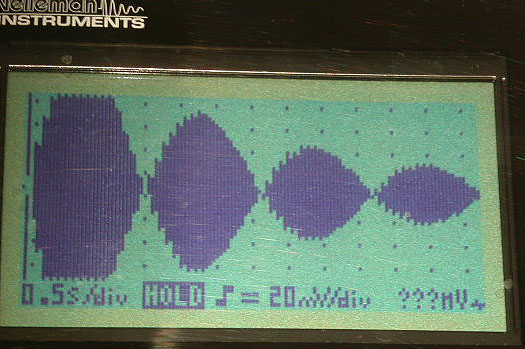
The Hum and its connection to the mains electrical supply
Observations on a vibrating mass carried out both indoors and in open fields show conclusively that the mass is subject to a modulating force which is neither electric or magnetic and yet is oscillating at the same frequency as the mains electrical supply, namely, 50 Hz.

The image Above shows a photo of an oscilloscope trace with the mass set to vibrate at 50.7 Hz.
Identical images can be obtained with the vibrator in a closed metal box or when observations are made in an open field indicating that the modulating force is neither electric or magnetic.
Observations on the walls of buildings reveal a voltage, which is approximately sinusoidal, has a frequency of 50 Hz and could easily be mistaken for the mains, however, there are important differences which can be observed with care.
The wall voltage changes with atmospheric conditions and can be seen to change dramatically when a storm cloud passes directly overhead. The waveform is only approximately sinusoidal and can also be observed to change with changing atmospheric conditions. It can also be observed that the wall voltage is NOT in phase with the mains supply.
The voltage is not evenly distributed over the surface of a wall but exists in patches of varying amplitude, however, there is one constant fact, the highest voltages are found at the highest parts of the building going to zero at ground level The highest voltages were obtained on outward facing load-bearing walls with the voltage slightly lower on the outside of the building compared to the same position on the inside of the building. Although the highest voltages are obtained from the walls, the same voltage but much smaller can be observed in floors and ceilings.
Reports gathered over many years show that the Hum level is not altered by switching off the mains supply to the building or by local power cuts and this leaves only the high voltage grid supply to explain the source of the Hum. The simple electric and magnetic fields depicted as emanating from the transmission lines cannot of themselves account for the Hum for the distance of these fields is measured in yards whereas reliable reports from Hum sufferers show that the effects would have to travel at least 50 miles from the pylons and possibly much further.